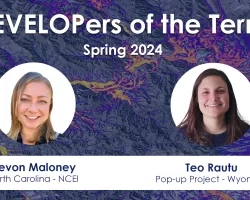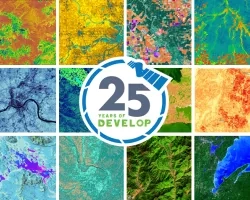
DEVELOP’s summer 2020 term began on June 1st and will conclude on August 7th. Sixty-five participants are working on 15 projects across the areas of Disasters, Ecological Forecasting, Energy, Health & Air Quality, Transportation & Infrastructure, Urban Development, and Water Resources. Learn more about the summer 2020 projects being conducted below!
The Maryland – Goddard DEVELOP team is working on the Ellicott City Disasters III project, which will build an operational threat matrix based on statistical flood modeling for improving early warning systems in Ellicott City, Maryland. Over the past ten years, Ellicott City has experienced multiple detrimental flooding events, claiming human lives and causing infrastructure damage. While the town has faced flooding issues for over 100 years, the local flooding dynamics are changing in both frequency and intensity. Accurate, timely, and detailed data reports are necessary to mitigate the effects of severe flooding in the region and inform early warning systems. The operational hazard matrix tool and spatially enhanced flood risk model will supplement the emergency management actions of the Howard County Government’s Office of Emergency Management by quantifying flood risk in real-time and demonstrating its spatial extent.
The Rocky Mountain Disasters team from the Colorado – Fort Collins DEVELOP location is studying communities along the Colorado Front Range that have experienced several catastrophic wildfires in recent decades and are facing a future with increased fire frequency and severity. Understanding the impacts of severe fire on forest regeneration and water quality is critically important for communities across the western United States. Maps characterizing vegetation recovery following fires, and information about the drivers of these recovery patterns, will benefit partners by evaluating relationships they have identified in their transect- and watershed-scale work at larger scales, across multiple fires. The proposed products can help adapt and target late-stage restoration treatments.
The Colorado – Fort Collins DEVELOP team is conducting the Fisher’s Peak Ecological Forecasting project. Historically, Fisher’s Peak Ranch has been privately owned with very little anthropogenic disturbance. As such, the property contains extraordinary natural resources that need to be inventoried and assessed during its development into Colorado’s second largest state park. End products will assist the partners in making informed planning decisions as they transition Fisher’s Peak Ranch. A reliable map of the vegetation communities on the property, which is not currently available, will provide a critical baseline to support planning, management, and long-term monitoring of this area.
The Idaho – Pocatello DEVELOP team is working on the Mark Twain National Forest Ecological Forecasting project. Pine species have been heavily logged and restoration efforts are increasing to combat the lack of native species in an otherwise hardwood dominated forest. Land managers use pine stands as markers for shallow or exposed soil in the national forest to help generate maps of areas in need of restoration. The team will create a cover type analysis of the forest canopy to assist forest managers to completely map the landcover types of the forest. This will eventually assist managers in the creation of species-level classifications. The map will then be forecasted out to the year 2040 to observe changes in cover type while considering current management practices. The cover map will be integrated with elevation models on-hand so forest managers can strategize their focus on restoring glade habitat across the 1.5 million acres of public land.
The Southern Bhutan Ecological Forecasting team from the Maryland – Goddard location will highlight wildlife corridors by generating habitat suitability maps and land cover classifications for the Bhutan region. The diverse landscapes of Bhutan host a rich biodiversity of animal and plant species. Elephants are a flagship species whose conservation is essential for the functioning of the forest ecosystem. The Asian elephant faces threats of extinction throughout its range, so planning and supporting wildlife corridors is important. There is an opportunity to use satellite data to inform conservation decisions and generate information that contributes to the protection of ecosystems.
The Georgia – Athens DEVELOP team is working on the Georgia Energy III project, which will create an environmental sensitivity public mapping tool to reduce habitat and solar site conflict in Georgia. Many optimal locations for solar farms overlap with the habitat of the gopher tortoise and the black bear. In 2018, building began for the largest solar site in the U.S. in Twiggs County, which is also home to the largest growing black bear population. This has driven recent conservation efforts to save key flora and fauna in the state. Map products showing the evolution (2017 – 2020) of land conflict between key species habitat and optimal solar sites will help understand the rate of conflict changes since The Nature Conservancy and Georgia Department of Natural Resources began this focused conservation effort. A Solar Suitability Tool will assist solar developers in the identification of key ecosystem locations for planning purposes.
The Satellite Beach Energy team from the Arizona – Tempe DEVELOP location will quantify solar energy potential estimates by building, which will provide invaluable information for decision making as Satellite Beach transitions to 100% clean energy. The team will also assess areas with excess stress on air conditioning use through greenness and land surface temperature analysis. The development of a reusable tool, with known and adjustable assumptions, will improve partners confidence in the reliability of the data on which they base their policy decisions for locally generated solar energy and energy use reduction initiatives.
The California – Ames DEVELOP team is working on the Pacific Northwest Health & Air Quality project, which will analyze wildfire impacts on air quality in the Pacific Northwest. There is mounting evidence that the threat of wildfires will increase under climate change, posing a public health hazard from increased wildfire smoke. Inhalation of wildfire smoke is associated with adverse health effects, including coughing, wheezing, and worsening of lung conditions, which is a significant concern among community members and policy makers across Washington, Oregon, and the broader Pacific Northwest. In small communities east of the Cascade mountains, air quality monitoring stations are geographically sparse, which makes determining hazardous air quality levels difficult. This project will analyze air quality impacts to inform The Nature Conservancy’s forest management practices and Puget Sound Clean Air Agency’s targets. The project will also generate a web-based tool to visualize and analyze air quality in the region, which will provide supplemental air quality information where on-the-ground sensors are geographically sparse.
The Alaska Transportation & Infrastructure team from the California – JPL DEVELOP location is identifying permafrost subsidence using NASA Earth observations to pinpoint road and infrastructure vulnerability. Significant localized permafrost thaw is occurring in interior Alaska, especially in places where natural insulative vegetation has been removed. When ice-rich permafrost thaws, surface deformation and subsidence occur, posing a serious threat to Alaska’s infrastructure by leading to decreased structural integrity of the ground and subsequent damage to roads and structures.
The team from DEVELOP’s Massachusetts – Boston location is conducting the Cambridge Urban Development project. The urban heat island (UHI) effect is a phenomenon that makes urban areas significantly warmer than surrounding suburban or rural regions. As climate change advances, cities like Cambridge, MA expect to see serious impacts on residents’ health, local environmental features, and infrastructure due to the UHI effect. The city is currently monitoring impervious surface area and canopy cover within the city but has limited methods of tracking changes in urban albedo. Cambridge is creating a Climate Change Preparedness and Resiliency plan to prepare for potential impacts, like the increased UHI effect. Remote sensing products and NASA Earth observations will enable the partners of this project to assess changes in albedo through time and albedo’s influence on the UHI effect. This provides the city with additional information as they seek to adapt to future threats to public health and economic well-being.
The Alabama – Marshall DEVELOP project team will be analyzing Huntsville Urban Development. An unchecked loss of trees in Huntsville, AL could have negative effects on the environment and the local community. With the city’s expansion, the effects of tree canopy loss could enhance the UHI effect and pose health risks to vulnerable populations within the city. This research can assist decision makers mitigate tree loss and analyze current UHI effects taking place within the city. The project’s end products may contribute to a better understanding of this situation and improve public awareness for tree conservation.
The Bhutan Water Resources team from the Alabama – Marshall DEVELOP location will assist the Himalayan Environmental Rhythm Observation and Evaluation System (HEROES) project in assessing climate vulnerability in Bhutan. Bhutan has experienced increased warming, and this has resulted in severe changes to its local climate. The Bhutan HEROES project employs a combination of weather data collection and citizen science to understand climate change. Satellites have been collecting data about our planet and its climate on a global scale for decades and can supplement the HEROES project by providing timely, consistent, actionable data to understand and adapt to climate change. Including satellite data as an additional monitoring tool will promote better understanding of climate change and its impact on biodiversity in Bhutan.
The team from the North Carolina – NCEI DEVELOP location is working on the Cherokee Water Resources project focusing on the Qualla Boundary, the land trust of the Eastern Band of Cherokee Indians (ECBI). Persistent drought conditions in the fall of 2016 exacerbated forest fires in the counties intersecting this region. Forest management practices can reduce dry fuel availability, and forest composition maps from multiple data sources can improve the effectiveness of these targeted management practices. This project will leverage satellite-derived optical and LiDAR imagery to determine forest canopy fractional part and year-to-year change in composition for the Qualla Boundary and surrounding counties. This information will contribute to ECBI efforts to map forest structure and expand their resources for monitoring forest change in response to drought and other disturbances.
DEVELOP’s Virginia – Langley Riley County Water Resources project is studying the recent flooding of Wildcat Creek, which caused extensive damage to businesses and residents of Manhattan, Kansas and their rural surroundings. This unprecedented flooding may be attributed to long-term changes in land use that has influenced runoff in recent decades. The analyses will enable community development officials to better understand the evolution of watersheds in Riley County and to expand scientifically informed decisions on resiliency actions.
The Virginia – Langley DEVELOP team is conducting the South Carolina Water Resources project, which will assess increased rates of erosion in salt marshes due to sea level rise. Unvegetated to vegetated marsh ratio will provide a meaningful measure of vulnerability that is less costly and labor-intensive to measure than a complete sediment budget evaluation. Decision makers at the state-level in South Carolina can use this information to better understand the prioritization of resources for restoration and preservation efforts.



